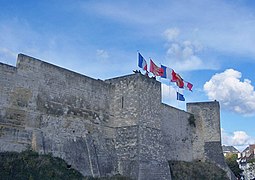Caen
Caen (/kɒ̃, kɑːn/, French: [kɑ̃] ⓘ; Norman: Kaem) is a commune 15 km (9.3 mi) inland from the northwestern coast of France. It is the prefecture of the department of Calvados. The city proper has 105,512 inhabitants (as of 2018), while its functional urban area has 470,000,[3] making Caen the second largest urban area in Normandy and the 19th largest in France.[4] It is also the third largest commune in all of Normandy after Le Havre and Rouen.[5][6]
Not to be confused with Cannes.
It is located 200 km (120 mi) northwest of Paris, connected to the South of England by the Caen (Ouistreham) to Portsmouth ferry route through the English Channel. Situated a few miles from the coast, the landing beaches, the bustling resorts of Deauville and Cabourg, as well as Norman Switzerland and the Pays d'Auge, Caen is often considered the archetype of Normandy.
Caen is known for its historical buildings built during the reign of William the Conqueror, who was buried there, and for the Battle for Caen, heavy fighting that took place in and around Caen during the Battle of Normandy in 1944, destroying much of the city. The city has now preserved the memory by erecting a memorial and a museum dedicated to peace, the Mémorial de Caen.
Etymology[edit]
The first references to the name of Caen are found in different acts of the dukes of Normandy: Cadon 1021/1025,[7] Cadumus 1025,[8] Cathim 1026/1027.[9] Year 1070 of the Parker manuscript[10] of the Anglo-Saxon Chronicle refers to Caen as Kadum,[11] and year 1086 of the Laud manuscript[12] gives the name as Caþum.[13] Despite a lack of sources as to the origin of the settlements, the name Caen would seem to be of Gaulish origin, from the words catu-, referring to military activities and magos, field, hence meaning "manoeuvre field" or "battlefield".[14] In Layamon's Brut, the poet asserts that King Arthur named the city in memory of Sir Kay,[15] although the historicity of King Arthur is widely doubted.
Geography[edit]
Caen is in an area of high humidity. The river Orne flows through the city, as well as small rivers known as les Odons, most of which have been buried under the city to improve urban hygiene. Caen has a large flood zone, named "La prairie", located around the hippodrome, not far from the river Orne, which is regularly submerged.[18][19]
Caen is 10 km (6.2 mi) from the Channel. A canal (Canal de Caen à la Mer) parallel to the Orne was built during the reign of Napoleon III to link the city to the sea at all times. The canal reaches the English Channel at Ouistreham. A lock keeps the tide out of the canal and lets large ships navigate up the canal to Caen's freshwater harbours.
Main sights[edit]
Castle[edit]
The castle, Château de Caen, built c. 1060 by William the Conqueror, who successfully conquered England in 1066, is one of the largest medieval fortresses of Western Europe. It remained an essential feature of Norman strategy and policy. At Christmas 1182, a royal court celebration for Christmas in the aula of Caen Castle brought together Henry II and his sons, Richard the Lionheart and John Lackland, receiving more than a thousand knights. Caen Castle, along with all of Normandy, was handed over to the French Crown in 1204. The castle saw several engagements during the Hundred Years' War (1346, 1417, 1450) and was in use as a barracks as late as the Second World War. Bullet holes are visible on the walls of the castle where members of the French Resistance were shot during the Second World War. Today, the castle serves as a museum that houses the Musée des Beaux-Arts de Caen (Museum of Fine Arts of Caen) and Musée de Normandie (Museum of Normandy) along with many periodical exhibitions about arts and history. (See "Timeline of Caen Castle". Archived from the original on 13 February 2006. Retrieved 28 August 2004.)
Abbeys[edit]
In repentance for marrying his cousin Mathilda of Flanders, William ordered two abbeys to be built on the Pope's encouragement:
Mayors of Caen have included:
Joël Bruneau was re-elected mayor in the 2020 municipal elections.[1]
In 1952, the small commune of Venoix became part of Caen.[20]
In 1990, the agglomeration of Caen was organized into a district, transformed in 2002 into a Communauté d'agglomération (Grand Caen (Greater Caen), renamed Caen la Mer in 2004), gathers 29 towns and villages, including Villons-les-Buissons, Lion-sur-Mer, Hermanville-sur-Mer, which joined the Communauté d'agglomération in 2004. The population of the "communauté d'agglomération" is around 220,000 inhabitants.
In the former administrative organisation, Caen was a part of 9 cantons, of which it was the chief town. These cantons contained a total of 13 towns. Caen gave its name to a 10th canton, of which it was not part. Since the 2015 canton reorganization, Caen is part of the cantons of Caen-1, 2, 3, 4 and 5.[25]
Economy[edit]
The agricultural and food-processing Agrial cooperative has its head office on Caen. Agrial group processes vegetables, cider apples, milk, poultry and meat with the help of its 12,000 employees and all its partners.[32]
Music and theatre[edit]
The Théâtre de Caen (1963) is the home of the Baroque musical ensemble Les Arts Florissants. The organization was founded by conductor William Christie in 1979 and derives its name from the 1685 opera by Marc-Antoine Charpentier.









